Notes on OMPHALINOID SPECIES in the Pacific Northwest
Prepared for the Pacific Northwest Key Council
By Ian Gibson (South Vancouver Island Mycological Society)
Copyright © 2019 Pacific Northwest Key Council
Photo copyright held by each photographer
Do not copy photos without permission
A number of species in the Pacific Northwest are characteristically “omphalinoid”. The term is derived from the genus Omphalina and has been used to refer to stature type of that genus. A point of reference is the very common species Lichenomphalia umbellifera which used to be known as Omphalina ericetorum. Implied characters are a broadly convex to depressed cap, decurrent or subdecurrent gills, a cartilaginous stem (firm, tough, pliant, and less than 1 cm wide), and the absence of a ring or volva. We will consider only species with a whitish spore deposit. A further restriction, to eliminate some species which could otherwise be confused is to limit the cap diameter to 4 centimeters. This eliminates some large Clitocybe-like species (Ampulloclitocybe, Pseudoclitocybe, Pseudoarmillariella, Lepista (except Lepista tarda) and the larger Clitocybe species).
The smaller Clitocybe-like species may be difficult to differentiate. In fact the smaller Clitocybe species are mostly difficult to differentiate even from each other. Many of them have a non-cartilaginous stem, but this may be a difficult character to determine at times. Omphalinoid species sometimes have stems that are not clearly cartilaginous, and small Clitocybes may have stems that could be considered cartilaginous. This brings us to an important point.
The identification of an omphalinoid species should always be confirmed by close adherence to the species description. One of the reasons that a Key to Omphalinoid Species is not offered at this time is that omphalinoid species are best learned individually.
It should be pointed out that a depressed cap is not by itself enough to include a mushroom in this grouping. In a large percentage of gilled mushrooms, the margin rises above the center of the cap as it ages.
The list below includes some species that do not fit all the criteria above but might be looked for here. While Cantharellula umbonata averages less than 4 cm across it can exceptionally reach 7.5 cm.
Aphroditeola olida
Arrhenia (the omphalinoid species)
Cantharellula umbonata
Cantharellula oregonensis
Chromosera cyanophylla
Chrysomphalina aurantiaca
Chrysomphalina chrysophylla
Chrysomphalina grossula
Contumyces rosellus
Infundibulicybe trulliformis
Lichenomphalia hudsoniana
Lichenomphalia umbellifera
Loreleia marchantiae
Loreleia postii
Myxomphalia maura
Omphaliaster asterosporus
Omphaliaster borealis
Omphalina pyxidata
Pseudolaccaria pachyphylla
Pseudoomphalina angelesiana
Pseudoomphalina kalchbrenneri
Rickenella fibula
Rickenella swartzii
Xeromphalina (See separate key to Xeromphalina)
Aphroditeola olida (= Hygrophoropsis morganii)
| CAP 1-4 cm across, flat with downcurved margin, becoming funnel-shaped; pinkish fading to pale buff at times when old; bald to minutely fibrillose, slightly sticky to dry, margin wavy to cleft, not striate; flesh thin, white. GILLS decurrent, close, narrow, thickened, frequently forked; colored as cap or paler. STEM 1-3 cm x 0.2-0.6 cm, narrowing downwards, central or off-center; colored as cap or somewhat darker; dry, bald to minutely fibrillose. ODOR strongly fragrant, reminiscent of bubble gum, or according to some authors cinnamon candy, fruit candy, grape soda, fruit, or flowers. FRUITING on soil or conifer needles, associated with conifers. SPORE DEPOSIT whitish. MICROSTRUCTURES spores 3-5.5 x 2.5-4 um, elliptic to subfusiform, smooth, inamyloid to dextrinoid; basidia 2-spored or 4-spored; pleurocystidia and cheilocystidia absent. REMARKS Outstanding features are pinkish colors and odor of bubble gum, root beer, cinnamon candy, or fruit. SOURCES>/b> Bigelow(6), Breitenbach(3), Phillips(1), Arora(1), Bessette(2), Moser(1), Trudell(4).
|
Aphroditeola olida
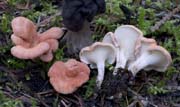
© Andrew
Parker |
Arrhenia chlorocyanea - verdigris navelcap
| CAP 1-2.5 cm across, disc becoming shallowly depressed and the margin downcurved; hygrophanous, dark green to sometimes dark blue, fading paler, finally pale buff; moist, bald or fibrillose to somewhat furfuraceous, margin striate when fading; flesh cap-colored near surface, whitish near gills. GILLS decurrent, subdistant to distant, narrow to moderately broad (up to 0.4 cm), forking and anastomosing, interveined; pale greenish aging pale buff. STEM 2-3 cm x 0.2-0.3 cm, equal or the top widened; colored as cap or more blackish, not fading; bald, dull. ODOR earthy or slightly fishy. TASTE mild. FRUITING in the open on thin soil, sometimes mosses, grass, or lichens, November to May, at least BC, WA, and CA. SPORE DEPOSIT white. MICROSTRUCTURES spores 7.5-11 x 4.5-6 um, elliptic to oval, smooth, inamyloid; basidia usually 4-spored; pleurocystidia and cheilocystidia absent; cap cutis "dark green to brownish green in KOH, hyphae cylindric or slightly inflated", 4-8.5(16) um wide, surface with protruding cystidioid end cells in places; stem cortical region with encrusted pigments on hyphae; clamp connections present. SOURCES Bigelow(5), Moser(1), Arora(1), Redhead(6), Redhead(38), Siegel(2).
|
Arrhenia chlorocyanea
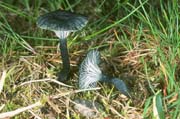
© Sharon Godkin |
| SPECIES |
HABITAT |
MOIST CAP COLOR |
SPORES (1) |
OTHER |
| epichysium (2) |
Wood |
Dark brown or gray-brown |
6-13 x 3.5-6.5 μm |
|
| onisca |
Sphagnum or other mosses |
Blackish or dark brown or gray-brown |
6-10 x 4-6 μm |
Cap 1-5 cm, umbilicate to funnel-shaped, obscurely meshed, indistinctly striate; usually fruits in fall |
| sphagnicola |
Sphagnum |
Gray-brown or brown-gray, sometimes olive tints |
6-14 x 3-5 μm |
Cap 1-3 cm, deeply funnel-shaped, minutely erect scaly, distinctly striate; fruiting June and July |
| obscurata |
Soil or among mosses |
Dark brown |
6-13 x 4-7 μm |
Cap 0.5-1.5cm, gills similar color to cap, moist cap somewhat different brown from A. hohensis, spores vary in shape, no stem hairs |
| hohensis |
Soil or among mosses |
Dark brown |
7.5-10 x 5-6.5 μm |
Cap 0.5-1.6(3) cm, gills paler than cap, moist cap somewhat different brown from A. obscurata, spores consistently ellipsoid to broadly ellipsoid, some stem hairs |
| rainierensis |
Soil or among mosses |
Dark gray brown to brownish gray or vinaceous gray |
5-10 x 4-6.5 μm |
Cap 1.0-2.5 cm, spores vary in shape, obovoid to pear-shaped in face view, tear-shaped in side view |
| pubescentipes |
Soil or among mosses |
Dark gray brown to brownish gray or vinaceous gray |
6.5-9 x 4.5-6 μm |
Cap 0.5-1.3 cm, spores broadly ellipsoid |
|
These species have small circular caps that rarely reach 4 cm across. Gills are decurrent and cap is usually at least somewhat depressed before the margin is elevated. Cap and gills are dark brown to blackish when fresh and moist, and the gills are usually gray, gray-brown or dark-colored.
The first three differ from the others in the habitat they prefer. The next two have predominantly dark brown color when moist and the last two have a grayer color when moist. . The differences are often subtle and it would be legitimate to call collections Arrhenia obscurata group.
There are a number of small, dark Clitocybe species described by Bigelow in his monograph, most of them rarely identified. The macroscopic differentiation of the group discussed here from the Clitocybe species rests insecurely on the omphalinoid stature of the group discussed here and the clitocyboid stature of Clitocybe species. Mushrooms with an omphalinoid stature have a cartilaginous stem, whereas those with clitocyboid stature have a fleshy fibrous stem. The following Clitocybe species can be small and dark with gray or gray-brown gills and should be considered when specimens have the following special characters.
- C. pungens - odor of green corn
- C. profundidisca - weak alkaline odor and violaceous stem
- C. ditopa - farinaceous odor and taste, round or nearly round spores
- C. epigaea - pungent fragrant odor
- C. peltigerina - habitat on Peltigera lichen
- C. adustiterricola - habitat on burned ground
- C. concava - 3-6 cm cap, spores 6-8 x 3-4 μm
Other species that could possibly be confused are the following:
- Lichenomphalia umbellifera is commoner than all of these Arrhenias, but the fruitbody is light brown to yellowish tan and has a greenish lichen at the base.
- Pseudoclitocybe cyathiformis 2.5-8cm cap, amyloid spores, usually on or near wood
- Myxomphalia maura grows on burnt ground and has pale gills.
- Uncommonly encountered species include Fayodia bisphaerigera (pale gills, round spores that appear spiny), and Omphaliaster asterosporus and O. borealis (nearly round spores with spines).
Footnotes:
- Spore measurements are similar in many of these species. The larger spores may arise from basidia with fewer than 4 sterigmata. Sizes can be variable but they are useful to confirm that the species in this group rather than one of the Clitocybe species with different spore size. Shapes can also be variable, for example in A. onisca and A. obscurata, but they are useful to distinguish A. pubescentipes and A. ranierensis.
- Hansen & Knudsen say that Arrhenia epichysium is probably identical to Arrhenia onisca, with the name sometimes being reserved for the form that grows on wood.
References: Bigelow(5), Breitenbach(3), Hansen, L.(2), Moser(1)
|
Arrhenia epichysium
| CAP 1-3 cm across, grayish brown to dark brown or light grayish brown, hygrophanous and fading paler; soon depressed, smooth or at center minutely scaly, margin striate; flesh grayish. GILLS decurrent, close to subdistant, narrow to medium broad, at times forking and interveined; pale grayish brown or gray. STEM 1-3 cm x 0.1-0.4 cm, sometimes widening slightly downward; dark brown to grayish brown; colored as cap or sometimes darker when old; bald in upper part, base sometimes with whitish basal tomentum. ODOR and TASTE mild. FRUITING on decayed wood of conifers or hardwoods, at least WA, OR, ID, and CA. SPORE DEPOSIT white. MICROSTRUCTURES spores 6-13 x 3.5-6.5 um, elliptic, smooth, inamyloid; basidia usually 4-spored; cheilocystidia: marginal cells on gills inconspicuous, vesicular to polymorphic-clavate, up to about 25 x 10 um; clamp connections present. REMARKS Arrhenia onisca is almost identical but it "grows in moors among Sphagnum, its odor is somewhat aromatic-fruity, the cap surface is darker and shiny when moist, and it lacks the marginal cells identifiable in O. epichysium", (Breitenbach for Europe, but Hansen, L.(2) says that the two are probably the same species). Other Arrhenia species in similar habitat to A. onisca in Europe include Arrhenia sphagnicola with a pubescent stem or a scaly disc, and lighter in color than Arrhenia onisca, (Breitenbach for Europe). SOURCES Bigelow(5), Bessette(2), Arora(1), Breitenbach(3).
|
Arrhenia epichysium
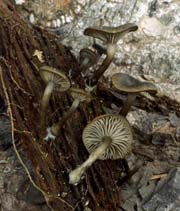
© Steve Trudell |
Arrhenia hohensis
CAP 0.5-1.6(3) cm across, disc slightly depressed; hygrophanous, dark brown when moist, fading to brownish gray; appearing bald or disc fibrillose, margin striate when moist, crenate [scalloped] when old; flesh colored as cap surface. GILLS broadly adnate then decurrent, distant, broad (about 0.3 cm); grayish brown or brownish gray; edges at times darker than faces. STEM 1-2.5(3.5) cm x 0.05-0.1(0.2) cm, equal, colored as cap, unpolished, bald or sometimes pruinose or with short fine hairs. ODOR mild or rarely faintly fragrant. TASTE mild. FRUITING on sandy soil, among lichens and mosses at times, May to July, September to November, found at least in WA (type), BC, and ID. SPORE DEPOSIT white or whitish. MICROSTRUCTURES spores 7.5-10 x 5-6.5 um, elliptic, smooth, inamyloid; basidia usually 4-spored; pleurocystidia and cheilocystidia not mentioned; clamp connections present. SOURCES Bigelow(5).
Arrhenia obscurata
| CAP 0.6-1.5 cm across, convex-depressed; hygrophanous, fuscous when moist, fading in streaks to gray; bald, margin striate when moist; flesh colored as cap; GILLS decurrent, subdistant to distant, narrow to broad; colored as moist cap but fading more slowly. STEM 1-2 cm x 0.1-0.25 cm, equal; colored as moist cap but fading more slowly; bald. ODOR and TASTE usually mild. FRUITING scattered on sandy soil or sometimes on moss, June to September, at least ID and CA, and commonly reported elsewhere in the Pacific Northwest. SPORE DEPOSIT white. MICROSTRUCTURES spores (6)7.5-10(11) x 4-5(6) um, elliptic to elliptic oblong in face view, at times somewhat tear-shaped or obovate in side view, at times polymorphic, smooth, inamyloid; basidia usually 4-spored; pleurocystidia and cheilocystidia not mentioned; cap cutis yellowish brown in KOH, pigment heavily encrusted, hyphae 2.5-7.5(1) micron wide, cylindric; clamp connections present. SIMILAR Clitocybe peltigerina has spores that are consistently elliptic to broadly elliptic. SOURCES Bigelow(5).
|
Arrhenia obscurata
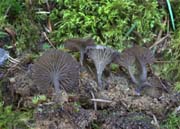
© Richard Morrison |
Arrhenia onisca
| CAP 1.1-4.5 cm across, disc soon depressed, becoming broadly funnel-shaped, margin remaining horizontal or downcurved at times; hygrophanous, dark brown to nearly blackish brown when moist, fading to grayish brown; bald when moist but with appressed radiate fibrils when faded or dry, margin striate when moist, margin sometimes scalloped; flesh colored as cap. GILLS long-decurrent, close to subdistant, narrow (up to 0.3 cm), rarely forked; grayish brown; interveined, at times with a bloom. STEM 2-4 cm x (0.1)0.2-0.5 cm, equal or top somewhat widened; colored as cap; bald above, base with whitish to grayish tomentum. ODOR and TASTE mild. FRUITING on sphagnum or other mosses or burned moss hummocks, September to November usually, rarely June and early July, at least WA, OR, ID. SPORE DEPOSIT white. MICROSTRUCTURES spores 6-8.5(10) x 4-5(6) um, broadly elliptic, smooth, inamyloid ; basidia mostly 4-spored; pleurocystidia and cheilocystidia not mentioned; clamp connections present. SIMILAR Arrhenia onisca is similar apart from the habitat, and Hansen, L.(2) say the two are probably the same species. Arrhenia sphagnicola is similar and similarly favors sphagnum. It is minutely erect-scaly, translucent-striate, and fruits early in the season. SOURCES Bigelow(5), Hansen, L.(2).
|
Arrhenia onisca
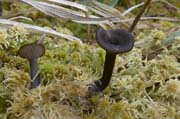
© Michael Beug |
Arrhenia pubescentipes
CAP 0.5-1.3 cm across, finally flat, depressed, margin incurved at first and finally arched; hygrophanous, watery sooty to vinaceous gray to brownish gray, fading paler; unpolished, innately fibrillose, sometimes scaly when old, margin striate when moist; flesh white. GILLS decurrent, distant or subdistant, alternating with subgills, broad; colored as cap or dark gray, edges darkening when old. STEM 1-1.8 cm x 0.1-0.4 cm, nearly equal; white-pubescent (finely downy); brownish gray or nearly colored as gills beneath the fine white hairs. ODOR and TASTE mild. FRUITING on soil (especially sandy) or moss, single in greenhouse pot, June, July, September, found at least in ID. SPORE DEPOSIT white or whitish. MICROSTRUCTURES spores 6.5-9 x 4.5-5(6) um, broadly elliptic, smooth, inamyloid ; basidia 4-spored; pleurocystidia and cheilocystidia not mentioned; clamp connections present. SIMILAR Arrhenia rainierensis fruitbodies average larger and spores are differently shaped, (Bigelow). SOURCES Bigelow(5).
Arrhenia rainierensis
| CAP 1-2.5 cm across, becoming shallowly depressed; hygrophanous, blackish brown then dark brownish gray, fading to dull ash-gray; bald when moist, hoary or faintly fibrillose to minutely scaly when faded, margin striate when moist; flesh colored as cap. GILLS adnate then decurrent, close to subdistant, narrow to broad; grayish brown to brownish gray or dark gray, unchanging. STEM 1-1.5 cm x 0.15-0.4 cm at top, equal or flared at top; colored as moist cap; pubescent (finely downy) except at top. ODOR and TASTE mild. FRUITING on soil or moss of wet road banks, September, October, found at least in WA (including type). SPORE DEPOSIT white or whitish. MICROSTRUCTURES spores (5)6-8.5(10) x (4)4.5-5.5(6.5) um, (from one-spored basidia up to 15 x 10 um), obovate to pear-shaped in face view, tear-shaped in side view, smooth, inamyloid; basidia usually 4-spored; pleurocystidia and cheilocystidia not mentioned; clamp connections present. SIMILAR Arrhenia pubescentipes fruitbodies average smaller and spores are broadly elliptic. SOURCES Bigelow(5).
|
Arrhenia rainierensis
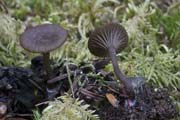
© Michael Beug |
Arrhenia sphagnicola
| CAP 0.8-2(3.7) cm across, becoming funnel-shaped; hygrophanous, grayish brown to brownish gray, often with olivaceous tints, dingy dark brown when old, fading to dingy buff; fibrillose soon breaking into minute, darkening, scurfy points especially on disc, margin finely scalloped at times, margin translucent-striate when moist; flesh colored as cap. GILLS long-decurrent, subdistant, narrow, usually forking; whitish at first but soon tinged ashy, finally darkening to olivaceous gray beige, or dingy yellowish. STEM 1-5 cm x 0.1-0.4cm, equal or base somewhat widened; colored as cap at first but darker when old; bald in upper part, base pruinose to tomentose and fused with sphagnum. ODOR and TASTE slightly farinaceous when young, soon fading. FRUITING on sphagnum in bogs, June and July, rarely August, found at least in WA, (Bigelow(5)), spring, summer, fall, (Buczacki(1)). SPORE DEPOSIT white. MICROSTRUCTURES spores 6-14 x 3-5 um, elliptic to elliptic-oblong or subcylindric in face view, inequilateral in side view, sometimes polymorphic, smooth, inamyloid ; basidia 4-spored; pleurocystidia and cheilocystidia not mentioned; clamp connections present. SIMILAR Arrhenia onisca also grows on Sphagnum - its cap is 1-5 cm, very dark, almost black to cigar brown, narrowly umbilicate to funnel-shaped, indistinctly translucent-striate, and obscurely meshed, and its spores are ovoid, (Hansen, L.(2)). Arrhenia onisca usually fruits in fall. Arrhenia epichysium grows on wood. Arrhenia pubescentipes and Arrhenia obscurata grow on sandy soil but may grow on moss. SOURCES Bigelow(5) (as Clitocybe gerardiana), (Hansen, L.(2)) (as A. philonotis, of which they say O. sphagnicola is a dark form), Buczacki(1).
|
Arrhenia sphagnicola
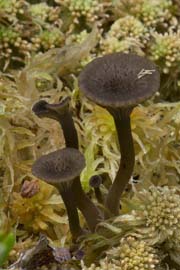
© Michael Beug |
Cantharellula oregonensis
CAP up to 4 cm, depressed or funnel-shaped; hygrophanous, pale isabelline (pale dingy yellowish brown); bald; flesh thin. GILLS short decurrent, subdistant, narrow, arched; "(presumably
concolorous with pileus) discolored on drying" (Bigelow). STEM 5 cm long, 0.5 cm wide, widening downward to enlarged base, fleshy; colored as cap; smooth, bald. FRUITING type found on ground in mixed woods in the foothills of the Cascades at 800 and 1200 feet, at least OR, rare. MICROSTRUCTURES spores 7.5-8.5 x 5.5-6 um, broadly elliptic, smooth, amyloid; basidia 2- and 4-spored; pleurocystidia and cheilocystidia presumably absent; clamps absent. REMARKS Pseudoclitocybe cyathiformis is much more common, with a dark brown to dark gray-brown cap when moist. It is generally larger and is described in the Key to Keys. See Cantharellula umbonata for a comparison with that species. SOURCES Bigelow(5).
Cantharellula umbonata - grayling
| CAP 1-5 cm, conic to convex often becoming depressed with a small umbo and sometimes a wavy margin, margin remaining downcurved; brownish gray to smoky or violaceous gray or buff to vinaceous buff, occasionally tinted greenish; dry, initially soft like leather becoming firmer and wrinkled, otherwise bald; flesh whitish, slowly bruising reddish where cut or handled or exposed. GILLS decurrent, crowded, narrow, thickish, regularly forked; whitish bruising or staining reddish brown or becoming yellowish in the edges near the cap margin. STEM 2-8 x 0.3-0.7 cm, more or less equal, tough; whitish to buff or sometimes with pinkish tint in lower part, silky to velvety, sometimes striate at top. ODOR faintly of cucumbers, or fragrant or not distinctive. TASTE mild. FRUITING among mosses, especially Polytrichum, at least BC, ID. SPORE DEPOSIT white. MICROSTRUCTURES spores (7.8) 8.5-10 (11.1) x (2.5) 3-3.5 (4.2) um, narrowly cylindric to fusoid-cylindric, smooth, amyloid, thin-walled, with 1-3 droplets; pleurocystidia and cheilocystidia not seen; clamps present. REMARKS 1) Features include a grayish umbonate dry cap, white flesh which sometimes stains reddish, crowded whitish forking decurrent gills which develop reddish brown patches, a white to grayish stem, and cylindric amyloid spores. 2) Pseudoclitocybe cyathiformis has a hygrophanous dark brown to gray-brown cap without an umbo, and close to subdistant, narrow to moderately broad, occasionally forking gills that do not stain reddish. It is generally larger and is described in the Key to Keys. 3) Cantharellula oregonensis (Murrill) Singer (==Pseudoclitocybe oregonensis (Murrill) Singer, == Clitocybe oregonensis Murrill) is poorly known but has broader spores 7.5-8.5 x 5.5-6 um. The fruitbody is said by Murrill to be hygrophanous and pale isabelline, which Bigelow interprets as sordid yellow. SOURCES Redhead(36), Phillips, Bessette(2), Redhead(6), Bigelow(5).
|
Cantharellula umbonata
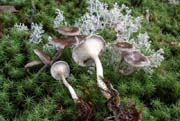
© Steve Trudell |
Chromosera cyanophylla
| CAP 0.3-2.6 cm, convex with a flattened to depressed center; dull orange-yellow, buttons often dull lavender but quickly changing to yellow, and larger caps may have faint rosy tints; viscid to greasy or slimy, bald, striate; flesh pale yellow. GILLS arched decurrent, 23-26 reaching stem, with 1-2 tiers of subgills, narrow (about 0.2 cm); pale lilac to pale vinaceous or rosy, fading when old, edges colored as faces. STEM 1-3 (4.5) x 0.1-0.25 cm, equal above a slightly swollen base, cartilaginous-fragile; colored as gills when very young, lower part soon becoming pale yellow but the basal mycelium remaining lilac; slimy-viscid, bald. ODOR and TASTE mild. FRUITING on decaying conifer wood, spring or fall, BC, WA, OR, ID. SPORE DEPOSIT white.MICROSTRUCTURES 6.5-9 (11) x 3.5-4.5 um, almond-shaped to elliptic, inamyloid, thin-walled; basidia 4-spored; pleurocystidia and cheilocystidia absent. SOURCES Redhead(41), Smith1) (as Mycena lilacifolia), Bessette(2).
|
Chromosera cyanophylla
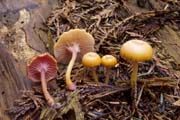
© Steve Trudell |
Chrysomphalina aurantiaca
| CAP 1-4 cm across, flat with margin inrolled and downcurved at first, finally often elevated", disc flat or shallowly depressed; hygrophanous, orange fading paler, yellowish to whitish when old; moist, fibrillose, fibrils often erect but finally appressed, margin striate, at first coated with white hairs; cap flesh colored as cap, stem interior whitish. ODOR and TASTE not distinctive. GILLS rather waxy-appearing, adnate to subdecurrent, becoming decurrent, distant, narrow, often forked, several tiers of subgills; orange to orange buff. STEM 1-3 cm x 0.15-0.5 cm, equal or slightly enlarged at either end, usually curved; pale orange or yellowish orange; bald. FRUITING gregarious on decaying conifer logs and other conifer wood and adjacent duff, typical fall but sometimes spring, BC, WA, OR, ID. SPORE DEPOSIT white to pale yellow. MICROSTRUCTURES spores (6.5)7-9(11.5) x 4-5(5.5) um, mostly elliptic, sometimes obovate, smooth, inamyloid; basidia usually 4-spored; pleurocystidia and cheilocystidia absent; clamp connections absent. SIMILAR The main features are the uniform orange color in cap, flesh, and stem, the moist hygrophanous cap with margin that is coated with tiny whitish hairs when young, waxy-appearing gills, and growth on rotting conifers. The bright color and somewhat waxy appearance of gills may cause confusion with hygrophoroid species. SOURCES Bigelow(9) (as Omphalina luteicolor), Bessette(1).
|
Chrysomphalina aurantiaca
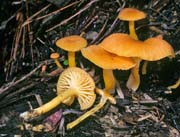
© Kit Scates Barnhart |
Chrysomphalina chrysophylla - goldgill navelcap
| CAP 0.5-4 cm across, convex to flat with shallowly depressed disc, more funnel-shaped when old; somewhat hygrophanous, most often yellow-brown but sometimes yellow or dusky brown or with orange or salmon or olive tint; moist to dry, minutely scurfy to fibrillose-scaly, margin opaque. GILLS decurrent, subdistant to distant, broad; yellow to orange-yellow. STEM 2-5 cm x 0.15-0.3 cm at top, equal or nearly so, often curved; yellow to orange-yellow or yellow-brown, or olivaceous-tinged; moist, bald or obscurely fibrillose striate. ODOR mild or occasionally fragrant. TASTE mild. FRUITING gregarious on conifer logs, May to October, BC, WA, OR, ID. SPORE DEPOSIT off-white to buff or yellowish or light salmon-tinted. MICROSTRUCTURES spores 8.5-15.5 x 4.5-6(7) um, elliptic to elliptic oblong, or subfusoid to subcylindric, somewhat bent at times, smooth, inamyloid ; basidia mostly 4-spored; pleurocystidia and cheilocystidia absent; clamp connections absent. SIMILAR Pseudoarmillariella ectypoides has yellowish but not golden yellow gills and spore deposit is white. Chrysomphalina aurantiaca has uniform orange colors. Chrysomphalina grossula has greenish yellow colors, at least when young. SOURCES Bigelow(9) (as Omphalina chrysophylla), Norvell(1), Siegel(2).
|
Chrysomphalina chrysophylla
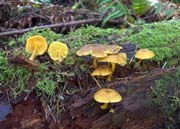
© Richard Morrison |
Chrysomphalina grossula
| CAP 2-3.5(6) cm across, becoming convex-umbilicate, to uplifted when old, margin even, scalloped or occasionally grooved; hygrophanous, at first pale yellowish green to greenish yellow or brownish yellow, becoming paler with age or even whitish; bald, moist, striate to disc; flesh pale yellow in cap and stem. GILLS decurrent, distant, 1-2 tiers of subgills, 0.1-0.15(0.3) cm broad, often interveined; yellowish or greenish yellow, becoming slightly paler to whitish with exposure or when old, retaining greenish-yellow color longer than cap. STEM 0.5-4(5.5) cm x 0.15-0.7(1) cm at top, more or less equal; yellowish or greenish-yellow, gradually paler toward base, appearing bald to naked eye but sparsely downy under magnification. ODOR and TASTE not distinctive. FRUITING on water-soaked conifer wood, bark chips, conifer debris, in mixed forests or parks, summer and fall, BC, WA, OR, and ID. SPORE DEPOSIT whitish, may appear very slightly greenish when deposited on glass. MICROSTRUCTURES spores 5.9-9.6 x 3.7-5.5(6) um, elliptic, smooth, inamyloid; basidia usually 4-spored, ratio of basidioles to sterigmate basidia very high; cheilocystidia and pleurocystidia absent; clamp connections absent. SIMILAR The yellow or faded forms of Lichenomphalia umbellifera may be similar if the latter are growing on conifer logs, but L. umbellifera 1) is surrounded at the base by green lichen thallus, 2) may develop fairly conspicuous pubescence on stem (unlike C. grossula), and 3) has hyphae in the cap and gill trama that are relatively narrow (4-10 um wide) and not normally swollen at the septa (those hyphae in Chrysomphalina grossula markedly are inflated, reaching 22 um wide, and constricted at the septa), (Norvell). Chrysomphalina aurantiaca is uniformly orange. Norvell(1) says C. chrysophylla never has greenish tints. Siegel(2), on the other hand, says that C. chrysophylla may be olive-gold at first and that C. grossula has pale yellowish green colors when young. There are microscopic differences as well. SOURCES Norvell(1), Siegel(2) p342.
|
Chrysomphalina grossula
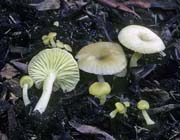
© Kit Scates Barnhart |
Contumyces rosellus
| CAP 0.7-3(4) cm across, convex to flat becoming deeply umbilicate to cup-shaped; vinaceous-brown or brownish-vinaceous to pale brown or buff often flushed with vinaceous or flesh color; more or less bald to pruinose-punctate, sometimes powdered with pastel vinaceous crystals, becoming punctate scaly or granular with darker scales, becoming partly translucent-striate; flesh pallid, unchanging. GILLS decurrent, subdistant, 2-3 tiers of subgills, narrow (0.15-0.35 cm), only occasionally forking; vinaceous purple, pale grayish vinaceous, or brown vinaceous, fading in some but retaining darker tints along margins or in spots. STEM 1.5-3.5 cm x 0.15-0.3 cm, with slightly swollen base, cartilaginous; russet-vinaceous to pinkish; with dark fine scales or granules, dull, basal mycelium a light grayish vinaceous bloom on the base. ODOR faintly of geraniums or Philadelphus lewisii (mock orange). TASTE not distinctive. FRUITING on soil among mosses, moist shady sites in spring, WA and OR, (Redhead(55)), on soil "among grass, lawns, pastures, woodland, also dunes", fall, winter, spring, (Buczacki for type variety). SPORE DEPOSIT white to pinkish, at least for type variety (Buczacki). MICROSTRUCTURES spores (7.3)9-11(12) x (4)5-6 um, elliptic to narrowly almond-shaped or pip-shaped, smooth, thin-walled, inamyloid, many with small refractive internal bodies; basidia (2-)4spored; cheilocystidia (36)45-72 x (5.5)6-8(8.5) um, hair-like ("unevenly narrowly lageniform or narrowly fusoid to hyphal-like, tending to project well beyond basidia when fully developed"), pleurocystidia occasional and usually near gill edge, similar to cheilocystidia; pileocystidia and caulocystidia present; clamp connections abundant. REMARKS This is derived except where specified from the description for Omphalina rosella var. vinacea, differing from the type variety in having vinaceous color (rather than a pale dingy pink color with a dirt brown center), and spring fruiting. Siegel(2) gave a description of Contumyces rosellus from the redwood coast of CA with cap color rosy pink to light pastel pink, paler variants creamy buff or pale pinkish beige, gills often rosy pink when very young, stem pinkish to beige pink, often darkest at top, and spores 11-14 x 5-6 um, fruiting late fall through spring, usually on bare soil, gravel, or sand with short grass or weeds. SOURCES Redhead(55) (as Omphalina rosella), Redhead(59) (as Contumyces rosella), Buczacki(1), Siegel(2).
|
Contumyces rosellus
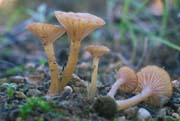
© Nathan Wilson |
Infundibulicybe trulliformis
| CAP (0.7)1.5-4(5) cm across, finally broadly funnel-shaped, margin broadly wavy at times; grayish to grayish brown, darkest on the disc and sometimes blackish, margin sometimes whitish; dry, disc velvety to minutely furfuraceous-scaly, coating appressed near margin, sometimes marked with river-like lines when old, margin not striate; flesh whitish. GILLS adnate to decurrent, close to subdistant, narrow (0.1-0.3 cm broad), usually forked, interveined or anastomosing at times; whitish to pale yellowish. STEM 1-4.5 cm x 0.15-0.5 cm at top, equal or narrowing downward slightly; pale dingy buff to pale olivaceous buff or pale gray, darker than gills but paler than cap; bald or innately fibrillose-striate, base usually has whitish mycelium and a few rhizoids. ODOR and TASTE farinaceous. FRUITING on humus under conifers or hardwoods, May to October, BC, WA, OR, ID. SPORE DEPOSIT white. MICROSTRUCTURES spores (4)4.5-6(7) x 2.5-3.5(4) um, elliptic, smooth inamyloid; basidia 4-spored; pleurocystidia and cheilocystidia not mentioned; clamp connections present. SOURCES Bigelow(5) (as Clitocybe trullaeformis).
|
Infundibulicybe trulliformis
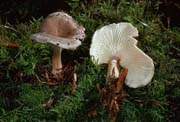
© Michael Beug |
Lichenomphalia hudsoniana - Hudson's basidiolichen
CAP 0.8-2.3 cm across, disc soon shallowly depressed, finally flat or rarely broadly funnel-shaped; hygrophanous, bright orange-yellow when moist, fading slowly to whitish; surface bald or with fine white downy hairs about the disc, sometimes somewhat waxy-appearing; margin scalloped, sometimes faintly striate; flesh colored as cap surface. GILLS adnate, soon becoming decurrent, subdistant to distant, broad (0.3-0.4 cm); near the color of the moist cap but not fading; waxy-appearing. STEM 1.5-2 cm x 0.15-0.3 cm, usually equal, often curved; with fine downy white hairs, translucent white to buff or pale orange-yellow or light olive, always fruiting from a gray-green foliose to squamulose lichen thallus. ODOR and TASTE mild. FRUITING associated with the lichen Coriscium viride on arctic or alpine peat and soil, sometimes on mossy or rotting logs and stumps, June to August, BC and circumpolar, the lichen having pale green, slightly concave squamules up to 0.5 cm wide much like a Cladonia but sometimes develops a more elongate, lobed thallus. SPORE DEPOSIT pale buff to pale orange-yellow. MICROSTRUCTURES spores 6-8(9) x 4-5(6) um, usually elliptic, sometimes obovate or oblong, smooth, inamyloid; basidia usually 4-spored; cystidia usually not differentiated; clamp connections absent, (Bigelow), spores 8.5-10 x 4.5-5.2 (Laursen(1) who gave 7-8 x 6-7 um for Lichenomphalia umbellifera). SIMILAR Lichenomphalia umbellifera has a white spore deposit, its stem is bald or only slightly pubescent, and it is associated with a different lichen. SOURCES Bigelow(9) (as Omphalina hudsoniana), Brodo(1), Laursen(1).
Lichenomphalia umbellifera - lichen agaric
| CAP 0.5-1.5(3.5) cm across, disc soon shallowly depressed, when old sometimes funnel-shaped; somewhat hygrophanous, light brown when young becoming paler and more yellowish when old or drying, finally pale yellowish to whitish, the disc often remaining dark for some time; moist but not viscid, bald, margin striate when moist and often wavy and somewhat scalloped, pleated at times, opaque when old and fading. FLESH colored as cap. GILLS decurrent, subdistant or distant, narrow to moderately broad (0.1-0.3 cm), sometimes forking, sometimes interveined; pale yellowish to pale creamy. STEM 1-3(4) cm x 0.1-0.3 cm at top, equal or either end slightly enlarged, often curved; pale vinaceous brown to yellow brown or pale brown; bald or nearly so in upper part, base with slight white tomentum. ODOR and TASTE mild. FRUITING associated with a green granular lichen, on moss, conifer logs or soil, any month of the year, BC, WA, OR, ID. SPORE DEPOSIT white to yellowish (Arora). MICROSTRUCTURES spores 7-9(10) x 4-6(7) um, up to 12 x 8 um from 1-spored basidia, elliptic, smooth, inamyloid; basidia often 2-spored but also 1-, 3-, or 4-spored; cystidia not differentiated; clamp connections absent. SIMILAR In arctic or alpine habitats consider Lichenomphalia hudsoniana. Arrhenia species are differently colored (darker brown or green) and not associated with the green granular crust. SOURCES Bigelow(9) (as Omphalina ericetorum), Arora(1) (as Omphalina ericetorum).
|
Lichenomphalia umbellifera
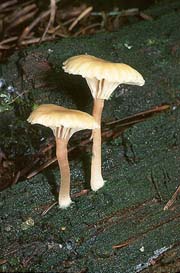
© Sharon Godkin |
Loreleia marchantiae
| CAP 0.3-1.2 cm across, convex becoming flat with slight umbo then umbilicate; orange-brown; buttery-shiny, bald, translucent-striate; flesh orange-brown. GILLS long-decurrent, 8-16 gills reaching stem, 1 subgill between each pair of gills, broad, some forked; white to cream or with orange tint. STEM 1.5-2.5 cm x 0.1-0.2 cm, cylindric, often bent, base somewhat wider; more or less colored as cap, pale orange-brown, base paler to whitish; smooth, shiny. ODOR and TASTE mild. FRUITING single to gregarious among vegetation of springs or in wet places, among or near liverworts, especially Marchantia, summer to fall, BC, WA. SPORE DEPOSIT white. MICROSTRUCTURES spores 7-12 x 4.7-6.6 um, elliptic - tear-shaped, smooth, inamyloid; basidia (2-)4-spored; pleurocystidia and cheilocystidia not seen; clamp connections absent. SOURCES Breitenbach(3) (as Gerronema), Moser(1) (as Gerronema), Courtecuisse(1) (as Gerronema).
|
Loreleia marchantiae
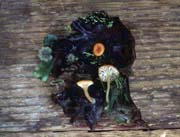
© Paul Kroeger |
Loreleia postii - tiny navelcap
| CAP 0.5-2(5) cm across, disc deeply depressed from the first, margin remaining inrolled and downcurved for some time, broadly vase-shaped when old; somewhat hygrophanous, orange or reddish, paler to orange-buff when old; moist, bald to finely downy, striate when moist, wavy-scalloped when old; flesh dull orange or yellow. GILLS decurrent, close to distant, narrow to moderately broad, often interveined, occasionally forking; whitish at first becoming yellowish or yellowish pink; slightly waxy-appearing at times, interveined. STEM 2.5-8(10) cm x 0.1-0.3(0.5) cm, equal or slightly widened in lower part; pale orange yellow to pale yellow, base sometimes pallid and with slight mycelium; moist, sparsely pruinose especially near top, soon bald. ODOR and TASTE not distinctive. FRUITING on mosses and liverworts, wet soil around springs, seepage areas or brooks, or burned soil and fireplaces, May to October, WA, OR, ID. SPORE DEPOSIT white. MICROSTRUCTURES spores 6.5-11 x 4.5-6(6.5) um, elliptic, smooth, inamyloid; basidia 2-spored or 4-spored; cystidia not differentiated; clamp connections absent. SIMILAR Rickenella fibula is similar, but Loreleia postii is larger, has a bald rather than pubescent stem, and has larger spores, no cystidia, and no clamp connections. SOURCES Bigelow(9) (as Omphalina), McKnight(1) (as Omphalina), Hansen, L.(2) (as Gerronema).
|
Loreleia postii
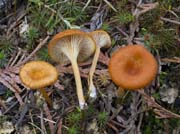
© Andrew Parker |
Myxomphalia maura
| CAP 1-3.5 (5) cm, convex or centrally depressed with an incurved margin, becoming flat or centrally depressed; dark grayish-brown or olive-brown to blackish-brown, fading to gray or paler; viscid when moist but soon dry, smooth, cap skin separable, margin finely striate at first; flesh pliant, dark watery gray. GILLS adnate to slightly decurrent, close, 3 tiers of subgills, broad, white or grayish but always much paler than cap or stem. STEM 2-6 x 0.2-0.6 cm, colored more or less like cap, smooth, top pruinose but soon becoming bald and polished overall. ODOR mild or farinaceous or fruity. TASTE mild or farinaceous. FRUITING on burned soil and debris, especially under conifers, fall or spring, at least BC, WA, ID. SPORE DEPOSIT white.MICROSTRUCTURES spores 4.5-6.5 x 3.5-4.5 um, broadly elliptic to nearly round, smooth or with minute scattered warts, amyloid; basidia 4-spored; pleurocystidia and cheilocystidia similar, 30-90 x 6-9 um, subcylindric above an abruptly narrowed pedicel, colorless. SOURCES Smith(15) (as Omphalina maura, Arora(1), Bigelow(4), Bigelow(6).
|
Myxomphalia maura
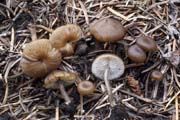
© Steve Trudell |
Omphaliaster asterosporus
CAP 2.2-3.3 cm, flat, disc slightly depressed; hygrophanous, gray brown, fading soon to faintly grayish; dry, bald, margin striate when moist; flesh very thin, colored as cap. GILLS adnate then short decurrent, subdistant, broad, not forked or interveined; gray brown. STEM 2.5-3.5 x 0.3-0.4 cm, equal, hollow, curved; colored as cap; bald and more or less translucent. ODOR and TASTE farinaceous. FRUITING on moss under pine and hemlock, WA, OR, apparently rare. SPORE DEPOSIT whitish. MICROSTRUCTURES spores 5.5-7 x 5.5-7 um, round or 5.5-7.5 x 4.5-5.5 um, nearly round, nodulose with nodules up to 3 um, inamyloid; pseudocystidia present; clamps absent, (Bigelow), spores 6-8 x 6-8 um including spines up to 1.5 um long, (Hansen). REMARKS features include hygrophanous gray brown often umbilicate cap with striate margin, adnate to short decurrent subdistant broad gray brown gills, farinaceous odor and taste, growth on moss under conifers, whitish spore deposit, and round or nearly round spores with blunt spines; Omphaliaster borealis has deeply umbilicate cap and at most faintly striate cap margin. SOURCES Bigelow(6), Hansen, L.(2).
Omphaliaster borealis
CAP 2.2-3.3 cm, flat, disc slightly depressed; hygrophanous, gray brown, fading soon to faintly grayish; dry, bald, margin striate when moist; flesh very thin, colored as cap. GILLS adnate then short decurrent, subdistant, broad, not forked or interveined; gray brown. STEM 2.5-3.5 x 0.3-0.4 cm, equal, hollow, curved; colored as cap; bald and more or less translucent. ODOR and TASTE farinaceous. FRUITING on moss under pine and hemlock, WA, OR, apparently rare. SPORE DEPOSIT whitish. MICROSTRUCTURES spores 5.5-7 x 5.5-7 um, round or 5.5-7.5 x 4.5-5.5 um, nearly round, nodulose with nodules up to 3 um, inamyloid; pseudocystidia present; clamps absent, (Bigelow), spores 6-8 x 6-8 um including spines up to 1.5 um long, (Hansen). REMARKS features include hygrophanous gray brown often umbilicate cap with striate margin, adnate to short decurrent subdistant broad gray brown gills, farinaceous odor and taste, growth on moss under conifers, whitish spore deposit, and round or nearly round spores with blunt spines; Omphaliaster borealis has deeply umbilicate cap and at most faintly striate cap margin. SOURCES Bigelow(6), Hansen, L.(2).
Omphalina pyxidata - common navelcap
CAP 1-2.5(4) cm across, convex at first, with disc depressed and margin incurved, expanding to broadly funnel-shaped, but often remaining with a spreading margin; hygrophanous, dark reddish brown to dark vinaceous brown at first, paler with expansion, "but the striations remaining dark and prominent, fading with age or loss of moisture to buff or grayish vinaceous"; moist, bald, striate when moist, opaque when faded; flesh whitish. GILLS decurrent, close to subdistant, narrow at mid-portion to moderately broad, forking at times, usually not interveined; pallid to pale vinaceous gray. STEM 1-3(4) cm x 0.1-0.4 cm, equal or nearly so; colored as cap or top somewhat paler, "faintly pruinose at first but soon naked and polished", base with slight white mycelium. ODOR and TASTE mild. FRUITING usually on moss in the open, sometimes on wet sand or gravel, May to December, WA, OR, ID. SPORE DEPOSIT white. MICROSTRUCTURES spores (6)7-9(11) x 4-5(6) um, elliptic to oval, smooth, inamyloid; basidia mostly 4-spored; pleurocystidia and cheilocystidia: Breitenbach(3) mentioned cylindric cells on the gills, “some subcapitate or slightly gnarled or flexuous apically”; clamp connections present. REMARKS The description is derived from Bigelow(5). At least some Pacific Northwest records may be Contumyces rosellus. Siegel(2) commented regarding Contumyces rosellus in the redwood coast area of CA, "Confusion with Omphalina pyxidata seems to have been common in California for some time; we suspect that only C. rosellus occurs in our area." SOURCES Bigelow(5) (as Clitocybe pyxidata), Breitenbach(3).
Pseudolaccaria pachyphylla (= Clitocybe incomis)
| CAP 0.6-3.3 cm across, convex, umbonate, centrally slightly depressed, margin often furrowed or crisped and scalloped; usually buff to yellow-brown, sometimes with cinnamon or honey tints; dry, opaque, smooth to wrinkled, usually slightly fibrillose, occasionally with small shiny particles; flesh colored as cap or more yellowish. GILLS adnate to short-decurrent or slightly adnexed, close to subdistant, 1-2 tiers of subgills; vinaceous buff to buff or whitish, often developing yellowish tints especially toward cap margin. STEM 2-4.5 cm x 0.1-0.3 cm, mostly equal and often curving slightly; colored as cap; dry, finely striate, often finely fibrillose, usually with white basal mycelium. ODOR indistinctive to farinaceous. TASTE similar to odor or somewhat bitter. FRUITING in the open on bare soil or sand, sometimes in grass or in Polytrichum moss, in open coniferous woods (hemlock, pine), June to October, (Bigelow), BC, WA, OR, ID. SPORE DEPOSIT white. MICROSTRUCTURES spores 6-11 x 4.5-6 um, elliptic, kidney-shaped, oboval, or cylindric, smooth, inamyloid; basidia usually 4-spored; cheilocystidia absent to abundant but not forming a sterile edge, 25-70 x 6-7 um, "narrowly fusoid ventricose, sometimes forked or slightly contorted on the elongated neck, sometimes basidiole-like and merely mucronate or aculeate" (Redhead(4)); clamps present on all hyphae. SOURCES Redhead(4) (as Clitocybe incomis), Bigelow(5) (as Clitocybe fellea).
|
Pseudolaccaria pachyphylla
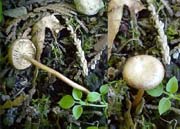
© Buck McAdoo |
Pseudoomphalina angelesiana (= Neohygrophorus angelesianus)
| CAP 1-3 cm across, convex, disc becoming slightly and shallowly depressed; dark gray to grayish brown or vinaceous brown; viscid to dry, bald, margin often scalloped or striate; flesh gray to gray-brown, turning reddish in 5% KOH. GILLS short-decurrent, close to distant, moderately broad, appearing waxy; lilac-gray to lilac-brown. STEM 2-5 cm x 0.3-0.8 cm, narrowing or widening slightly downwards; colored as cap, overlaid with white fibrils; base with white to lilac mycelium. ODOR and TASTE mild. FRUITING on soil and needles, typically in or near melting snowbanks, May to July, but restricted neither to snowbanks nor to spring fruiting. It was described from WA, but the question of further distribution is affected by the debate about whether Clitocybe mutabilis Bigelow is a synonym. SPORE DEPOSIT white. MICROSTRUCTURES spores 7-9(11) x 4-5.5 um, elliptic, smooth, amyloid; basidia 4-spored; pleurocystidia and cheilocystidia none; gill trama of distinctly interwoven hyphae 4-12 um broad, which are vinaceous red to haematite red in KOH; clamp connections present. SIMILAR Similar species have inamyloid spores or lack a reddish reaction to KOH. SOURCES Hesler(1) (as Hygrophorus), Bessette(1) (as Neohygrophorus), Desjardin(4) (as Neohygrophorus), Redhead(48) (as Neohygrophorus).
|
Pseudoomphalina angelesiana
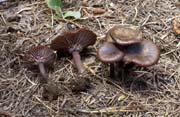
© Steve Trudell |
Pseudoomphalina kalchbrenneri
CAP 1-5 cm across, convex depressed to flat-depressed; hygrophanous, brownish when moist, fading to dingy buff; moist or dry, bald when moist, innately fibrillose when faded, margin usually not striate; flesh colored as cap surface. GILLS decurrent, moderately broad (up to 0.6 cm), subdistant to distant, 3 tiers of subgills, gills forked at times, interveined; pallid to grayish. STEM 1.5-6 cm x 0.2-0.9 cm at top, equal or either end slightly widened, curved at times; colored as cap or a bit darker; bald when moist, innately longitudinally fibrillose-striate when faded, base with whitish tomentum and sometimes with rhizomorphs. ODOR mild or faintly fragrant. TASTE mild. FRUITING on soil and needles under conifers or on exposed soil in roadway, July to October, WA, OR, ID, (Bigelow(5). SPORE DEPOSIT presumably white or whitish. MICROSTRUCTURES spores 6.5-9(10) x 3.5-4.5(5) um, elliptic to elliptic oblong, smooth, amyloid, sometimes weakly; basidia usually 4-spored; cheilocystidia present but rare, 1.5-3 um in diameter, protruding up to 45 um beyond gill edge, cylindric or sometimes capitate; cap surface slightly gelatinous-appearing in KOH, cutis yellowish to brownish in KOH, "pigment finely spirally encrusted or in slightly thickened walls" (Bigelow), hyphae 2.5-5.5(7.5) microns; clamp connections present. SIMILAR Clitocybe intermedia has a farinaceous odor and taste and its colors are less pale. REMARKS Pseudoomphalina kalchbrenneri is difficult to recognize in the field. It is characterized by pale gills, amyloid spores, encrusted pigments in the cap, and being one of the few Clitocybe-like species that may have true cystidia. SOURCES Bigelow(5) (as Clitocybe kalchbrenneri), Smith(48) (as Omphalia kalchbrenneri).
Rickenella fibula
| CAP (0.3) 0.8-1.2 (1.5) cm, slightly convex, flat or the disc faintly depressed at first, the margin straight or curved in slightly, when old the disc deeply depressed but the margin remaining downcurved; bright orange or ochraceous orange, soon changing to dingy ochraceous or buff, in some collections dull pale brown colors appear from the first; moist when fresh, striate; flesh pale orange to buff. GILLS long-decurrent, 17-20 reaching stem, 1 or 2 tiers of subgills, narrowed at extremities but broad in the notch between cap and stem, often interveined; white or whitish. STEM 1-4 x 0.1-0.15 (0.2) cm, equal; colored as cap and fading in the same manner; finely downy, becoming bald when old. ODOR and TASTE mild. FRUITING on beds of moss, BC, WA, OR, ID. SPORE DEPOSIT white. MICROSTRUCTURES spores 4.5-6 x 2-3 um, narrowly elliptic, inamyloid; basidia 4-spored; pleurocystidia and cheilocystidia scattered to abundant, 36-56 x 6-10 um, subcylindric to subfusoid, the apex tending to be more rounded than pointed, at times subcapitate. REMARKS Rickenella swartzii has different coloring but occurs in the same habitat and is associated with it fairly often. Omphalina and Chrysomphalina species may have cap with similar appearance, but Rickenella fibula has long stem, always grows with moss, and has conspicuous pileocystidia and pleurocystidia. SOURCES Smith(1). | Rickenella fibula
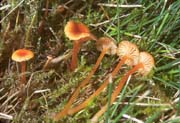
Ben Woo |
Rickenella swartzii
| CAP 0.6-1.2 cm, flat when young with margin downcurved, at maturity disc slightly depressed and the margin flat or slightly raised; violet brown to violet gray on disc, the margin paler pinkish brown; moist, striate, at first pruinose, becoming bald; flesh readily splitting radially. ODOR and TASTE mild. GILLS decurrent, 17-20 reaching stem, 1-2 tiers of subgills, narrow near cap margin but broad near stem; whitish. STEM 2-7 x 2-7 x 0.05-0.2 cm, violet brown at top and pinkish brown over lower half; pruinose. FRUITING on beds of moss or occasionally debris, spring, summer, or fall, BC, WA, OR, CA. SPORE DEPOSIT white. MICROSTRUCTURES spores 4-5 x 2-2.5 um, narrowly elliptic, inamyloid; basidia 4-spored; pleurocystidia and cheilocystidia scattered to abundant, 42-66 x 10-18 um, colorless, thin-walled, ventricose-subcapitate. REMARKS Rickenella fibula is normally bright orange or ochraceous orange, soon changing to dingy ochraceous or buff, but according to Smith, in some collections dull pale colors appear from the first. SOURCES Smith(1), Castellano(2). | Rickenella swartzii
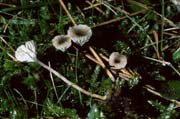
Sharon Godkin |
- Arora, David. 1986. Mushrooms Demystified Second Edition. Ten Speed Press, Berkeley. Arora(1)]
- Bigelow, Howard E. 1975. "Studies in the Tricholomataceae Hygrophoropsis, Cantharellula, Myxomphalia, Omphaliaster." Beihefte zur Nova Hedwigia 51 Studies on Higher Fungi pp61-78. J. Cramer. [Bigelow(6)]
- Bessette, Alan E., Arleen R. Bessette, Orson K. Miller, Hope H. Miller, 1995. Mushrooms of North America in Color: A Field Guide to Seldom-Illustrated Fungi. Syracuse University Press. [Bessette(1)]
- Bessette, Alan E., Arleen R. Bessette, David W. Fischer. 1997. Mushrooms of Northeastern North America. Syracuse University Press. [Bessette(2)]
- Bigelow, Howard E. 1970. “Omphalina in North America”. Mycologia 62: 1-32. [Bigelow(9)]
- Bigelow, Howard E. 1975. “Studies in the Tricholomataceae Hygrophoropsis, Cantharellula, Myxomphalia, Omphaliaster”. Beihefte zur Nova Hedwigia 51: 61-78. [Bigelow(6)]
- Bigelow, Howard E. 1979. “Notes on Fayodia ss. lato. Mycotaxon 9(1): 38-47. [Bigelow(4)]
- Bigelow, H.E. 1982. North American Species of Clitocybe, Part 1. Vaduz, West Germany: J. Cramer. and 1985. North American Species of Clitocybe, Part 2. Vaduz, West Germany: J. Cramer. [Bigelow(5)]
- Breitenbach, J., Kränzlin, F. 1991. Fungi of Switzerland Volume 3 Boletes and Agarics First Part. Edition Mykologia Lucerne. [Breitenbach(3)]
- Brodo, Irwin M., Sylvia Duran Sharnoff, Stephen Sharnoff. 2001. Lichens of North America. Yale University Press. New Haven and London. [Brodo(1)]
- Buczacki, Stefan. 2012. Collins Fungi Guide. Illustrated by Chris Shields and Denys Ovenden. HarperCollins Publishers London. 640 pp. [Buczacki(1)]
- Castellano, M., Efrén Cázares, Brian Fondrick, and Tina Dreisbach. 2003. Handbook to Additional Fungal Species of Special Concern in the Northwest Forest Plan. General Technical Report PNW-GTR-572. United States Department of Agriculture. [Castellano(2)]
- Desjardin, Dennis E., Michael G. Wood, Frederick A. Stevens. 2014. California Mushrooms - The Comprehensive Identification Guide. Timber Press, Portland, London. [Desjardin(6)]
- Hansen, Lise, Henning Knudsen editors. 1992. Nordic Macromycetes. Volume 2 Polyporales, Boletales, Agaricales, Russulales. Nordsvamp, Copenhagen. [Hansen, L.(2)]
- Hesler, L.R., Smith, A.H. 1963. North American Species of Hygrophorus. University of Tennessee Press, Knoxville. [Hesler(1)]
- Laursen, Gary, & Rodney D. Seppelt. 2009. Common Interior Alaska Cryptogams: Fungi, Lichenicolous Fungi, Lichenized Fungi, Slime Molds, Mosses, and Liverworts. University of Alaska Press. [Laursen(1)]
- Moser, M. 1983. Keys to Agarics and Boleti. Translated by S. Plant. Publisher Roger Phillips, London. [Moser(1)]
- Norvell, L.L., Redhead, S.A., Ammirati, J.F. 1994. “Omphalina Sensu Lato in North America 1: Omphalina wynniae and the genus Chrysomphalina 2: Omphalina sensu Bigelow”. Mycotaxon 50: 379-407 [Norvell(1)]
- Phillips, Roger. 1991. Mushrooms of North America. Little, Brown, & Co., Boston. 319 pp. [Phillips(1)]
- Redhead, S.A. 1984. “Mycological Observations 4-12: on Kuehneromyces, Stropharia, Marasmius, Mycena, Geopetalum, Omphalopsis, Phaeomarasmius, Naucoria and Prunulus. Sydowia 37: 246-270. [Redhead(4)]
- Redhead, S.A. 1986. "Cantharellula umbonata." Fungi Canadenses No. 301. Agriculture Canada, Ottawa. [Redhead(36)]
- Redhead, S.A. 1986. “Mycological Observations: 17-20, Nomenclatural notes on some Omphaloid genera in Canada: Chrysomphalina, Rickenella, Gerronema, Omphalina.” Acta Mycologica Sinica Suppl. I [Redhead(38)]
- Redhead, S.A. 1989. “A biogeographical overview of the Canadian mushroom flora.” Can. J. Bot. 67: 3003-3062 [Redhead(6)]
- Redhead, S.A., Glenn R. Walker, Joseph F. Ammirati, Lorelei L. Norvell. 1995. ”Omphalina sensu lato in North America 4: Omphalina rosella. “Mycologia 87(6): 880-885. 1995. [Redhead(55)]
- Redhead, S.A., J.F.Ammirati, L.L.Norvell. 1995. "Omphalina sensu lato in North America 3: Chromosera gen. nov." Beih. Sydowia 10: 155-167. [Redhead(41)]
- Redhead, S.A., Joseph M. Ammirati, Lorelei L. Norvell & Michelle T. Seidl. 2000. “Notes on western North American Snowbank Fungi.” Mycotaxon 76: 321-328. [Redhead(48)]
- Redhead, Scott A., and François Lutzoni, Jean-Marc Moncalvo, and Rytas Vilgalys. 2002. “Phylogeny of agarics: partial systematics solutions for core omphalinoid genera in the Agaricales (Euagarics).” Mycotaxon 83: 19-57. [Redhead(59)]
- Siegel, Noah, and Christian Schwarz. 2016. Mushrooms of the Redwood Coast - A Comprehensive Guide to the Fungi of Coastal North California. Ten Speed Press. Berkeley. [Siegel(2)]
- Smith, Alexander H. 1944. “Unusual North American Agarics.” American Midland Naturalist 32(3): 669-698. [Smith(48)]
- Trudell, Steve, Joe Ammirati. 2009. Mushrooms of the Pacific Northwest. Timber Press. [Trudell(4)]
- Smith, Alexander H. 1947. North American Species of Mycena. University of Michigan. [Smith(1)]
- Smith, A.H. 1949. Mushrooms in Their Natural Habitats. University of Michigan Press, Ann Arbor. [Smith(15)]
(Note that Descriptions are arranged alphabetically.)
| GENUS AND SPECIES |
| |
| APHRODITEOLA |
| A. olida (Quél.) Redhead & Manfr. Binder |
| = Hygrophoropsis olida (Quél.) Métrod |
| = Hygrophoropsis morganii (Peck) H.E. Bigelow |
| = Clitocybe olida (Quél.) Konrad |
= Clitocybe morganii (Peck) H.E. Bigelow
|
| ARRHENIA |
| A. chlorocyanea (Pat.) Redhead, Lutzoni, Moncalvo & Vilgalys |
| = Omphalina chlorocyanea (Pat.) Singer |
| = Omphalina viridis (Hornem.) Kuyper |
| A. epichysium (Pers.) Redhead, Lutzoni, Moncalvo & Vilgalys |
| = Omphalina epichysium (Pers.) Quél. |
| = Clitocybe epichysium (Fr.) H.E. Bigelow |
| A. hohensis (A.H. Sm.) Redhead, Lutzoni, Moncalvo & Vilgalys
|
| = Omphalina hohensis (A.H. Sm.) Norvell, Redhead & Ammirati |
| = Clitocybe hohensis (A.H. Sm.) H.E. Bigelow |
| A. obscurata (D.A. Reid) Redhead, Lutzoni, Moncalvo & Vilgalys |
| = Omphalina obscurata D.A. Reid |
| = Clitocybe atrobrunnea H.E. Bigelow |
| A. onisca (Fr.) Redhead, Lutzoni, Moncalvo & Vilgalys |
| = Omphalina oniscus (Fr.) Quél. |
| = Clitocybe onisca (Fr.) Raithelh. |
| A. pubescentipes (H.E. Bigelow) Redhead, Lutzoni, Moncalvo & Vilgalys |
| = Clitocybe pubescentipes H.E. Bigelow |
| A. rainierensis (H.E. Bigelow) Redhead, Lutzoni, Moncalvo & Vilgalys |
| = Clitocybe rainierensis H.E. Bigelow |
| A. sphagnicola (Berk.) Redhead, Lutzoni, Moncalvo & Vilgalys |
| = Omphalina sphagnicola (Berk.) M.M. Moser |
| = Clitocybe sphagnicola (Berk.) Raithelh. |
| = Clitocybe gerardiana (Peck) Singer |
| = Omphalina fusconigra P.D. Orton |
= Clitocybe fusconigra (P.D. Orton) H.E. Bigelow
|
| CANTHARELLULA |
| C. oregonensis (Murrill) Singer |
| = Clitocybe oregonensis Murrill |
| = Pseudoclitocybe luteicolor (Murrill) Singer |
| C. umbonata (J.F. Gmel.) Singer |
= Clitocybe umbonata (J.F. Gmel.) Konrad
|
| CHROMOSERA |
| C. cyanophylla (Fr.) Redhead, Ammirati, & Norvell |
| = Omphalina cyanophylla (Fr.) Courtec. & Bon |
| = Mycena lilacifolia (Peck) A.H. Sm. |
| = Omphalina lilacifolia (Peck) Murrill |
= Clitocybe lilacifolia Singer
|
| CHRYSOMPHALINA |
| C. aurantiaca (Peck) Redhead |
| = Omphalina luteicolor Murrill |
| = Clitocybe luteicolor (Murrill) H.E. Bigelow & A.H. Sm. |
| C. chrysophylla (Fr.) Clémençon |
| = Omphalina chrysophylla (Fr.) Murrill |
| = Gerronema chrysophyllum (Fr..) Singer |
| = Clitocybe luteophylla H.E. Bigelow & A.H. Sm. |
| C. grossula (Pers.) Norvell, Redhead & Ammirati
|
| = Omphalina grossula (Pers.) Singer |
= Gerronema grossulum (Pers.) Singer
|
| CONTUMYCES |
| C. rosellus (M.M. Moser) Redhead, Moncalvo, Vilgalys & Lutzoni |
| = Omphalina rosella (M.M. Moser) M.M. Moser ex Redhead, Ammirati, and Norvell |
= Clitocybe rosella M.M. Moser
|
| INFUNDIBULICYBE |
| I. trulliformis (Fr.) Gminder |
= Clitocybe trulliformis (Fr.) P. Karst. [as 'trullaeformis']
|
| LICHENOMPHALIA |
| L. hudsoniana (H.S. Jenn.) Redhead, Lutzoni, Moncalvo & Vilgalys |
| = Omphalina hudsoniana (H.S. Jenn.) H.E. Bigelow |
| = Clitocybe hudsoniana (H.S. Jenn.) H.E. Bigelow |
| L. umbellifera (L.) Redhead, Lutzoni, Moncalvo & Vilgalys |
= Omphalina ericetorum (Fr.) M. Lange
|
| LICHENOMPHALIA |
| L. marchantiae (Singer and Clemencon) Redhead, Moncalvo, Vilgalys, and Lutzoni |
| = Omphalina marchantiae (Singer & Clemencon) Norvell, Redhead & Ammirati |
| L. postii (Fr.) Redhead, Moncalvo, Vilgalys & Lutzoni |
| = Omphalina postii (Fr.) Singer |
= Clitocybe postii (Fr.) H.E. Bigelow
|
| MYXOMPHALIA |
| M. maura (Fr.) Hora |
| = Omphalina maura (Fr.) Quel. |
= Mycena maura Kühner
|
| OMPHALIASTER |
| O. asterosporus (J.E.Lange) Lamoure |
| O. borealis (M.Lange & Skifte) Lamoure |
= Clitocybe borealis (M. Lange & Skifte) P.D. Orton & Watling
|
| OMPHALINA |
| O. pyxidata (Bull. ex Fr.) Quél. |
= Clitocybe pyxidata (Fr.) Singer
|
| PSEUDOLACCARIA |
| P. pachyphylla (Fr.) Vizzini & Contu |
| = Pseudoomphalina pachyphylla (Fr.) Knudsen |
| = Clitocybe incomis (P. Karst.) P.D. Orton |
= Clitocybe fellea Peck
|
| PSEUDOOMPHALINA |
| P. angelesiana (A.H. Sm. & Hesler) Vizzini, Contu & Z.W. Ge |
| = Neohygrophorus angelesianus (A.H. Sm. & Hesler) Singer |
| = Hygrophorus angelesianus A.H. Sm. & Hesler |
| P. kalchbrenneri (Bres.) Singer |
= Clitocybe kalchbrenneri (Bres.) Raithelh.
|
| RICKENELLA |
| R. fibula (Bull.) Raithelh. |
| = Omphalina fibula (Bull.) Quel. |
| = Mycena fibula (Bull.) Kühner |
| R. swartzii (Fr.) Kuyper |
= Mycena swartzii (Fr.) A.H. Sm.
|
- END -

